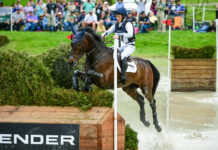The half-halt is elusive to many dressage riders. Performed correctly, it remains nearly imperceptible to onlookers, while providing necessary balance and connection to the horse. Fortunately, this technique is not as complicated as it sounds.
What’s in a Word?
Many riders find the half-halt concept mystifying. Contributing to this conundrum is the fact that a refined half-halt is barely visible. Half-halts are part of dressage riding; these small adjustments should be in every rider’s repertoire, at any level.
Most riders are familiar with the term “half-halt,” and yet there are many different interpretations, causing it to be something of a loaded concept for many. For Blitz, the solution lies in avoiding the umbrella term with her students, instead giving them specific instruction to address each individual issue.
“I rarely use the term ‘half-halt’ in any of my lessons, even with my advanced riders,” says Blitz. “The half-halt is a process, and often the part of the half-halt that’s the weakest link is what I address, rather than just saying ‘half-halt.’ I might say, ‘In this moment, the horse needs to balance back more; he isn’t carrying his weight enough,’ or, ‘The reaction to your leg is too slow.’ Basically the word ‘half-halt’ is not descriptive enough for riders. If you ask 10 people what it is, you’ll get 10 different definitions.”
Nevertheless, the term “half-halt” is one that riders come across again and again. So what is it exactly, and how do you ride one?
Full Circle
The multi-tasking half-halt performs many functions: rebalancing; regaining attention; adjusting tempo; improving contact; setting up for a transition between or within gaits; setting up for a movement, figure, or change of direction; increasing the horse’s core strength; asking for greater self-carriage and engagement; and more.
This subtle yet critical modification works by asking the horse to redistribute his weight back, engaging the hindquarters, lightening the forehand, and creating increased organization. The balancing act of restraining aids and driving aids allows the horse to come over his back to the bit, recycling energy from behind. Think full-circle readjustment.
The How-To
For the simplest explanation of how to ride a half-halt, Blitz breaks it down into three phases.
Slowing Phase: “You need to be sure you’re starting in a place of vertical alignment, so your shoulder, hip, and heel are in line,” says Blitz. “In the halt aid, avoid the natural instincts of sitting too far back, putting too much weight in your stirrup, or sitting up too tall. Your knee should have a fair amount of bend with lightness in the stirrup, so the stirrup isn’t used for extra power. Ask the horse to come back by closing your hand without pulling the rein back.

Start the half-halt from a vertically aligned position, then ask the horse to come back by closing your hand.
“The horse should have a longitudinal shift of weight toward the back, which is what happens when you stop or even rein-back a step. The horse should first respond by shortening his stride, which is the ‘halt’ part of the word half-halt,” explains Blitz.
Neutral Phase: “After the horse has come back to the degree that you want, open your hand and allow a bit of a rein release—not a complete dropping of the contact, but a release of the aid that told the horse to shorten his stride. Releasing the rein doesn’t mean ‘go,’ it means, ‘stay where I put you.’
“Once that’s established, the next thing to accomplish is that the shift of weight is sustainable, meaning the horse shouldn’t accelerate because of the give of the reins,” says Blitz. “The horse should remain there until he is instructed to do the next thing, which is to listen to the leg to energize again or cover ground. You maintain the same body position before your hand closes, while your hand closes, and after your hand closes. Your body stays lined up and passively, persistently organized.”
Energizing Phase: “The final step is very simply asking the horse to go from the lower leg to engage the hind leg, to energize, and to cover ground again; this should be sensitive, but not over-reactive,” says Blitz. “One of the main problems riders get into is if the horse doesn’t go from the lower leg, they start squeezing or shoving with the seat, which ends up pushing the horse’s back down. Once his back goes down, his head and neck go up.”

Use your lower leg to energize your horse and get him covering ground.
Getting the Feel
Like just about everything in riding, you really understand the half-halt once you’ve felt it. Nevertheless, getting to that point is not always so easy. “It’s impossible to describe feel; it’s like trying to describe the taste of something—not until it’s in the person’s mouth do they understand it,” says Blitz. “Even if I say the back feels supple, through and soft, how helpful are those words until the rider has felt it? This leaves riders searching for their own interpretation. Finding the right words to lead a rider to the feeling is an enormous challenge!”
The understanding of correct rider biomechanics is the essential ingredient to making the half-halt almost automatic. This, together with a clear explanation of technique, increase the likelihood of a positive response from your horse, giving you a better chance of finding the right feeling, allowing the whole process to make sense.
“I think the first mistake is the use of the term ‘half-halt,’ which we’ve all heard time and time again,” says Blitz. “It seems like simple language, but it’s not very descriptive. It’s a label for a moment, for a feeling, for a process—but these two simple words are meaningless until the rider has experienced it. Those words don’t lead a rider to the feeling or describe how to get there. There’s a big difference between a label and procedural information.” Once you understand how to ride the half-halt, then hearing that term in instruction can work successfully.
This simple yet subtle combination of aids, timing, and feel work together to balance the horse, creating the beauty for which dressage is known. Whether riding Intro Level or Grand Prix, half-halts help every horse.
Liked this article? Here’s more dressage training advice:
Three Exercises to Master the Halt
Half Halt How to
NATALIE DeFEE MENDIK is an award-winning journalist specializing in equine media, whose personal horse passions include dressage and vaulting. Visit her online at www.mendikmedia.com.
This article originally appeared in the December 2014 issue of Horse Illustrated magazine. Click here to subscribe!







Thanks for helping me understand “half halts” a bit better.
Great points. I use the half halt a lot in driving to regain focus and control.